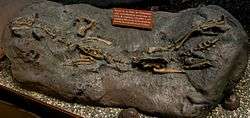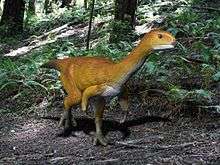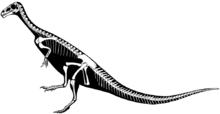Chilesaurus
| Chilesaurus diegosuarezi Temporal range: Late Jurassic, 145 Ma | |
|---|---|
 | |
| Cast of the holotype skeleton | |
| Scientific classification | |
| Kingdom: | Animalia |
| Phylum: | Chordata |
| Class: | Reptilia |
| Clade: | Dinosauria |
| Order: | Saurischia |
| Suborder: | Theropoda |
| Clade: | Tetanurae |
| Genus: | †Chilesaurus Novas et al. 2015 |
| Species: | †C. diegosuarezi |
| Binomial name | |
| Chilesaurus diegosuarezi Novas et al. 2015 | |
Chilesaurus is an extinct genus of herbivorous theropod dinosaur. The genus is monotypic, represented by the type species Chilesaurus diegosuarezi.[1] Chilesaurus lived approximately 145 million years ago (mya) in the Late Jurassic period of Chile.

Description

Chilesaurus measures 3.2 metres (10.5 ft) from nose to tail. The holotype is a smaller individual of half that length.
The most unusual feature of Chilesaurus consists in its spatula-shaped elongated teeth, obliquely pointing forwards. This dentition, unique in the Theropoda, is typical for a herbivore, indicating Chilesaurus was a plant-eater, unusual because its direct dinosaur relatives were meat-eaters. Another adaptation for eating plants is the backward-pointing pubic bone in the pelvis, making room for a large gut. Such a pelvic arrangement is typical for the Ornithischia, to which group part of the fossils of Chilesaurus were at first incorrectly referred. The hindlimb of Chilesaurus had become less adapted to running as shown by a small cnemial crest on the front top of the shinbone, and a broad foot with a weight-bearing first toe. Chilesaurus could defend itself with a strong arm, bearing a large first claw which could be extended outwards, just as with basal Sauropodomorpha.
Discovery and naming

Fossils of Chilesaurus, a vertebra and a rib, were first discovered on 4 February 2004 by the seven-year-old Diego Suárez who, together with his parents, geologists Manuel Suárez and Rita de la Cruz, was searching for decorative stones in the Aysén Region. More specimens were present that in 2008 were reported as representing several dinosaurian species.[2] Only later was it realised that these belonged to a single species with a bizarre combination of traits.
In 2015, the type species Chilesaurus diegosuarezi was named and described by Fernando Emilio Novas, Leonardo Salgado, Manuel Suárez, Federico Lisandro Agnolín, Martín Dário Ezcurra, Nicolás Chimento, Rita de la Cruz, Marcelo Pablo Isasi, Alexander Omar Vargas and David Rubilar-Rogers. The generic name refers to Chile. The specific name honours Diego Suárez.[1]

The holotype, SNGM-1935, was found in a layer of the Toqui Formation dating from the late Tithonian. It consists of an articulated rather complete skeleton with skull of a juvenile individual, lacking the feet and most of the tail. Four other partial skeletons (specimens SNGM-1937, SNGM-1936, SNGM-1938, SNGM-1888) and several single bones (specimens SNGM-1889, SNGM-1895, SNGM-1901, SNGM-1894, SNGM-1898, SNGM-1900 and SNGM-1903) are the paratypes. They represent juvenile and adult individuals.[1]
Classification
Chilesaurus was placed in the Tetanurae, in a basal position. It shows a confusing mix of traits normally present in Coelurosauria, basal Sauropodomorpha and Ornithischia but belongs to none of these groups.[1]
References
- 1 2 3 4 Novas, F. E.; Salgado, L.; Suárez, M.; Agnolín, F. L.; Ezcurra, M. N. D.; Chimento, N. S. R.; de la Cruz, R.; Isasi, M. P.; Vargas, A. O.; Rubilar-Rogers, D. (2015). "An enigmatic plant-eating theropod from the Late Jurassic period of Chile". Nature. doi:10.1038/nature14307.
- ↑ Salgado, L., De La Cruz, R., Suárez, M., Gasparini, Z. & Fernández, M., 2008, "First Late Jurassic dinosaur bones from Chile", Journal of Vertebrate Paleontology 28: 529–534
Further Reading
| Wikimedia Commons has media related to Chilesaurus. |